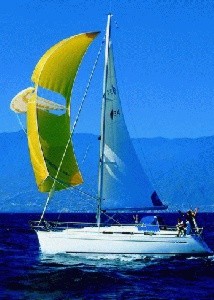New Spinnaker Technology
by Kate Elkington on 12 May 2003

Parasail Ian Mainsbridge
www.all2easy.com
The introduction of a new spinnaker system is set to revolutionise Australia's sailing industry.
Parasail, a groundbreaking new design in spinnaker sails, is now available in Australia following its successful launch in Europe by manufacturer Paramarine.
The Parasail is an innovative system that combines the traditional spinnaker theory and paraglider technology to improve safety, sailing comfort, performance and sail longevity.
The Parasail's design comprises a large big aperture in the upper third of the sail and a free-flying wing foil at the front, so wind effectively acts against the sail removing excessive pressure, improving stability and reducing roll.
In strong gusts, this aperture works as a pressure relief valve removing surplus strength out of the sails, which reduces stress and increases the life of the spinnaker. The intelligent shifting of this centre of pressure radically improves handling and performance at higher speeds.
The Parasail's subdivision of a classical spinnaker design makes the placing of a wing into the air current possible, similar to the construction of a normal paraglider. The air streams through the aperture and around the wing creating additional buoyancy and lift, rather than the traditional spinnaker effect which forces the yacht's bow into the water.
As a result, there is less friction on the hull due to a smaller fractioning surface and lower keel and rudder plate resistance through reduced rolling, which effectively increases speed.
Hoisting and lowering is eased thanks to a specially designed snuffer, which lifts simultaneously from the bottom and middle. Flying the Parasail involves much the same process as that required for a normal spinnaker, although less adjustment is needed thanks to the stability of the sail.
Tests have shown that flying the Parasail in ten knots of wind gives only 1.5% less power than a conventional spinnaker, with the added bonus that the sail does not require constant changing as conditions alter.
Parasail inventor Hartmut Shädlich developed the
technology after noting the discomfort created by traditional spinnakers.
'After spending many days rolling about on a yacht with a conventional spinnaker, I finally decided something must be done about it,' Shädlich said.
After developing the new wing design, it was tested on 20-22ft boats before being taking for advanced testing in the Daimler Chrysler wind tunnel in Germany.
'None of us could believe the results of the initial tests so we decided to do them again in the most stringent environment, Shädlich said.
The European trials of the Parasail showed radically superior results in safety, comfort and performance against tests on traditional spinnakers.
The results showed that the sail is able to start working in just five knots of wind and can remain flying in winds up to force ten.
Paramarine employed the most advanced three-dimensional software in the construction of the wing with high quality seamsmanship and uncompromised quality.
The company tested more than 150 materials for the sail itself, with the lines connecting the wing to the sail made from a very slippery fibre to prevent tangles.
The wing sections are made by specialists in Hong Kong, renowned for their parasail wings and widely regarded as the best manufacturers of these foils in the world. Other components are made in Germany, where the sails are built.
The Parasail is not just limited to small yachts and Paramarine has already built sails of 600-700m² and have just taken an order for a sail for a 32 metre catamaran.
In 2002 Paramarine sold 400 Parasails and they are currently selling at a rate of 20-30 per day in Europe.
The Parasail is now available in Australia and more information and orders can be obtained by contact EC Marine on 07 5448 3774, emailing info@ecmarine.com.au or visiting the website at www.ecmarine.com.au
EC Marine is also the Australian agent for world-renowned Fountaine Pajot caramarans.
If you want to link to this article then please use this URL: www.sail-world.com/9771